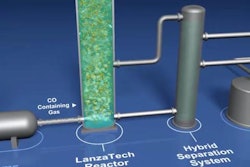Researchers at the U.S. Department of Energy's National Renewable Energy Laboratory (NREL) are working on the development of a microbe that can digest methane produced during the hydraulic fracturing process, better known as fracking. Methane is a byproduct of this process and can contribute large amounts of greenhouse gases (GHG) to the atmosphere.
NREL is working with the University of Washington, LanzaTech and Johnson Matthey to create microbes which convert methane in natural gas into liquid diesel fuel. In addition to reducing GHG emissions, this Bio-Genomes-to-Life (BioGTL) process could help minimize the United States' dependence on foreign oil.
Learn more about LanzaTech's work, including its process of converting carbon gas into fuel, in the article, "Alternative fuels."
The microbe Methylomicrobium buryatense 5GB1 was chosen for the project because it is one of the few bacteria that has a high natural potential for producing lipids—which can be used as a biological feedstock for hydrocarbon-based fuels—from any carbon source. Research to date has shown the microbe can double in size within three hours when grown in a simple mineral medium.
Next steps in the project will focus on genetically modifying the microbe to increase the amount of membrane lipids and get it to produce non-phosphorous-based lipids that can more easily be converted into fuels.
Read the full NREL article to learn more.



















